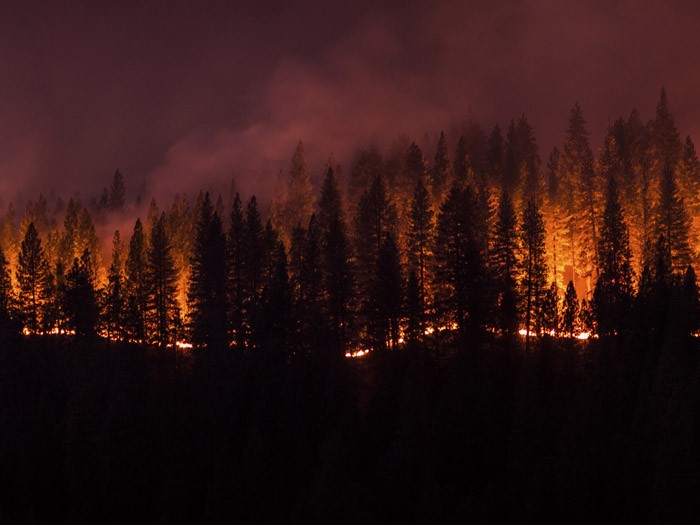Energy Industry
‘Among the Largest Catastrophe Losses in Canadian History’

About 2,400 structures in and around Fort McMurray lie in ruins in the middle of 700 charred square miles of northern Alberta.
The oil sands boom town, once known as “Fort Make Money,” is now going to cost money — at least $4 billion (C$5 billion) by early estimates — to rebuild after a monster wildfire swept around and through parts of town the first week of May.
The immediate insurance question is not the property loss in town; that is quite straightforward.
Rather, it is the length of the oil sands outage and two stages of business-interruption (BI) claims: immediate losses for the time out of operation, as well as possible contingent losses for refiners that rely on the oil sands for raw materials.
At the peak of the fire, 1 million barrels a day of oil sands production was taken out of service — about 40 percent of total output, and roughly one-quarter of all Canadian oil production.
Some operations have already airlifted in skeleton crews to begin safety checks in advance of resuming operations, but the bulk of production is expected to remain out of service for several weeks, if not a month or more.
The wildfires “will be a huge BI event,” said Paul Cutbush, senior vice president catastrophe management at Aon Benfield Analytics in Toronto.
“Even with no damage we will have to see when workers are allowed to come back — and then how many and how soon. A lot of these facilities have been used for evacuations, a goodwill gesture. A great deal will depend on manuscript wording for each policy.”
Waiting periods for BI claims will likely not be as large a factor as in past large losses, Cutbush noted. “It used to be that 90 days was standard. Today, that is shorter, 60 days, maybe even just 30.”
It may take longer than that to get claims sorted, because the size and scope of the fire has presented so many new unknowns.
“The biggest thing is getting people back to work,” said Cutbush, but they need places to live and shop.
“It is our understanding that a lot of the housing in the area was rental or temporary housing for oil sands and services workers.” That means not just property claims for the assets themselves, but lost value from their revenue.
Utilities and infrastructure also have to be inspected, repaired or replaced.
“There is also the issue of ash-contaminated water,” said Cutbush. “The Athabasca River is used for injection water, but ash can make the water caustic and not suitable for use without treatment.”
The fires continue to rage uncontrolled, but are now in the deep boreal forest south and east of town. The evacuation order and state of emergency for the area remained in effect as of May 11.
During a press tour through the town, Alberta Premier Rachel Notley gave the first official estimate of initial recovery time: “First responders and repair crews have weeks of work ahead of them to make the city safe. I’m advised that we will be able to provide a schedule for return within two weeks.”
Official numbers said 88,000 people, were evacuated, but a local source puts the number closer to 100,000, counting transient workers.
Remarkably, there has been no loss of life, not even any major injuries. And the vast oil sands mining and processing operations that sprawl for more than 100 miles in every direction around Fort McMurray were undamaged.
On May 10, Notley met with industry officials and was told the operations were secure.
“The magnitude of the current destruction suggest that the new fires will generate among the largest catastrophe losses in Canadian history, affecting both personal and commercial property writers,” according to an initial evaluation by the ratings agency Moody’s.
“I suspect some of the [energy companies’ insurance] coverage may be on the lean side.” — Jason Mercer, assistant vice president and analyst, Moody’s
“Early estimates of the wildfires peg the cost of damages rising to C$5 billion or around 1.5 percent of Alberta’s GDP — an estimate that could increase,” Moody’s reported.
“The Fort McMurray fires destroyed four times as many buildings as the Slave Lake [Alberta] wildfire of May 2011, which cost Canadian property and casualty insurers more than C$700 million in pretax losses.”
“Home and auto insurance coverage in Canada is substantially similar to that in the U.S.,” said Jason Mercer, assistant vice president and analyst at Moody’s in Toronto, who co-wrote the report.
“The only notable difference is that some lines, such as workers’ compensation, are typically government issued.”
BI is also similar in the two countries, Mercer noted. “There is named peril and all-risk. Both are available, but my sense is that all-risk is probably more difficult to get and more expensive, if only because of the higher number and cost of major losses in the province.
“More than half of the major losses in recent years in Canada have been in Alberta.”
Mercer also emphasized that the price of oil has been depressed for almost two years, leading some operators to tighten their belts – including insurance protection.
“I suspect some of the coverage may be on the lean side,” he said.
It will also depend whether companies have limited BI coverage — which would cover losses beginning with the evacuation and ending with the “all clear,” or extended coverage, which would “could run until there is a return to the profit level pre-event.”










